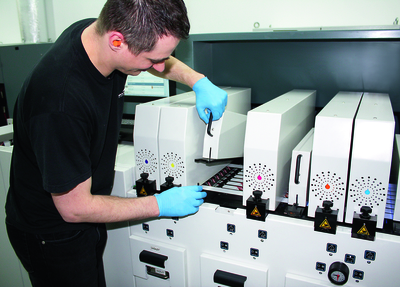Exploiting the full potential of digital UV inkjet depends on high press specification, ink technology, integrated software and long-term professional support, argues Bas Hoijtink, commercial manager graphics at SPGPrints.
Thanks to advances in resolution, set up times and productivity, the digital process has made short runs of high quality labels viable, with fast lead times. Brand owners are turning to the process for just-in-time deliveries that save supply chain costs. However, they also see digital’s potential for offering personalisation and for offering value-added services.
UV inkjet is an increasingly competitive option, and not just for micro runs. Thanks to performance improvements, the process makes it possible to achieve identical quality results to analogue, economically, for runs up to 4000 meters and beyond. UV inkjet is ideal for printing on film substrates; the inks offer the high gloss needed for brand impact, durability and fade resistance for external, industrial or harsh conditions, and the cost advantage of having no ‘click charges’. Presses offer scalability – extra width and extendability are possible, for example, by adding print heads.
The proliferation of UV inkjet technology providers makes that investment decision challenging. Consider the brand owner’s expectations for total flexibility from suppliers to print any job by either digital or analogue process and deliver identical results; run length determines which workflow you choose, not desired quality; deliveries within two to five workings days as the norm; serialised numbering ability to make adaptations to label design with ease; and the ability to offer micro-runs, eg samples.
It is possible to offer that flexibility, deliver astounding quality that makes shelf impact, and maintain low ownership costs, provided you have a fine-tuned workflow, based on a highly customised press specification, an ink system that works harmoniously with the press, integrated software and ongoing, expert technical support and advice.
Customised specification
A customised specification takes into consideration the end-user markets, applications, substrates to be printed on, and whether inline or near-line converting is most viable. For high-end labels, a press must demonstrate its ability to offer controlled quality on a wide range of substrates, a wide colour gamut and tonal range, and ability to include finishing and converting options.
Basic requirements, beyond inclusion of process colours, are control of the ink laydown and temperature of the substrate, to assure quality and substrate versatility without compromising speed. Intermediate pinning and chilling, therefore, should be standard.
LED pinning stations, located between sequential colour stations, ensure optimum colour generation, by perfectly spreading the new UV LED-skinned base colour on top of the previous colour. This results in crisp, small characters and fine linework.
When printing on film, temperature control is essential, to maintain stability and prevent warping. A chill drum, positioned after the printing stations, gives the versatility to print a wide range of materials, including PP, PE, PET, vinyl, BOPP, to be printed at full speed. This function has become more important as press speeds have increased and substrates have become thinner.

Bas Hoijtink
Extended gamut
A standard press features CMYK, but to be a reliable supplier to the major retail goods brands, more colours are needed inline.
SPGPrints is increasingly building UV inkjet presses with 10 colours. Adding orange and violet to the process colours makes it possible to replicate over 90% of the visible colour spectrum, including challenging fluorescent or psychedelic effects. An opaque white at the beginning of the printing sequence is essential in order to protect the integrity of the visible colours of a no-label look. Thanks to the development of inks with optical density values of 93%, the no-label look is easily achievable with UV inkjet. Other popular additional colours are spot colours, to provide a brand’s unique, legally protected colour.
The primer – an optional feature on advanced presses – further enhances versatility because it enables excellent ink adhesion on a wide range of substrates, including machine-coated papers, economically. No need for expensive, specially treated facestocks: the primer is applied in a controlled way, to the desired image area. Our customers are delivering high-impact results on Kraft and woven paper as a result.
The localised application of the primer is brand enhancing, because it sharpens the contrast between the UV inkjet colour’s natural vividness and the uncoated surroundings. Embossed-look features are essential for wines and cosmetic applications.
Single-pass, low-cost converting
Single-pass production means optimum productivity, minimum logistics and low set up times. Through partnerships between the press supplier and end-of-line technology providers, a full range of finishing and converting equipment can be seamlessly integrated. A flexo station is useful for applying matte varnishes to ensure an indistinguishable look to flexo. Semi-rotary die-cutting keeps tooling costs down. Further cost reductions are possible when flexible die-cutting plates are used on either digital or existing analogue presses. Laser die-cutting reduces set up times and tooling costs further.
Some converters, who may not require or be able to afford such a high specification immediately, should check whether retrofitting is possible. In a dynamic market such labels, the modularity of the press is a crucial consideration.
Ink innovations
It is essential for the ink to work perfectly with the ink head. The ink flow characteristics must be fine tuned to avoid jamming, which can result in printhead damage. A supplier that manufactures the ink and builds the press can bring chemists and engineers together, dedicated to optimising compatibility and further performance enhancements of the ink.
Examples of innovation in ink performance include optical density, light-fastness, chemical resistance and gloss values.
The printhead quality is not only determined by the resolution. A higher number of greyscale levels and drop sizes at linear increments enable a higher effective resolution and a wider tonal range respectively. High dot placement accuracy and temperature control via constant ink recirculation ensure quality consistency.
Integrated workflow
The time savings of the pre-press stage offer perhaps the most obvious advantage over analogue. Instead of 90 minutes to process the plates, about 15 minutes are required to handle the file and send it to press. Furthermore, several jobs can be programmed consecutively.
However, adapting to the new workflow is often the most challenging aspect of investing in the digital press, not least because one has to manage a significant increase in files all of a sudden.
To make the learning curve as fast as possible, the software should be compatible with the analogue system. The XML file is extracted from the converter’s MIS, complete with job specifications and step-repeat information, to the automation software, where a PDF file is generated for approval, without he need to duplicate inputs. The job then goes to the front-end server of the press, which should be able to manage several files at once. It becomes a joy to meet just-in-time demands, because the easiest jobs are repeat orders as they only require retrieving from the system, and a click of the mouse!
Technical support
The key to high productivity depends as much on the people as the technology. The converter can expect a six-month learning period to fully master the process. Expect the supplier, therefore, to offer practical training to ensure all staff are intimate with the process, workshops on how to print difficult substrates, and preventative maintenance courses. In the long term, your supplier should offer fast response advice on matters such as filter exchanges, or press settings. This safety net ensures the press achieves the highest possible uptime.
A responsible press supplier will make the effort, not just to train the customer in the new technology, but to equip them with market vision and expertise to offer – and create – new high-end services.
Repositioning your business
Digital printing does more than allow the converter to deliver short runs economically. It is a game changer, because of the bouquet of new added-value services that converters can offer as a result of adopting a digital workflow. Going digital enables you to offer the solutions for more brand variation, prototyping, web-to-print, serial numbering, accelerated lead times, lower warehousing costs and improved supply chain management.
Prototyping, especially, emphasises why as a converter, you should be talking to the marketing and brand managers, rather than just label buyers. Instead of photoshop and mock ups, a converter can offer an actual run of the tangible product on the press, in minutes, using the exact substrate components, inks and graphics. And if any further changes are needed, one simply adjusts the file and goes back to press.
With the right technology and strategic support, digital UV inkjet provides an escape from differentiating on price alone, and a way of transforming your customers’ operations.






